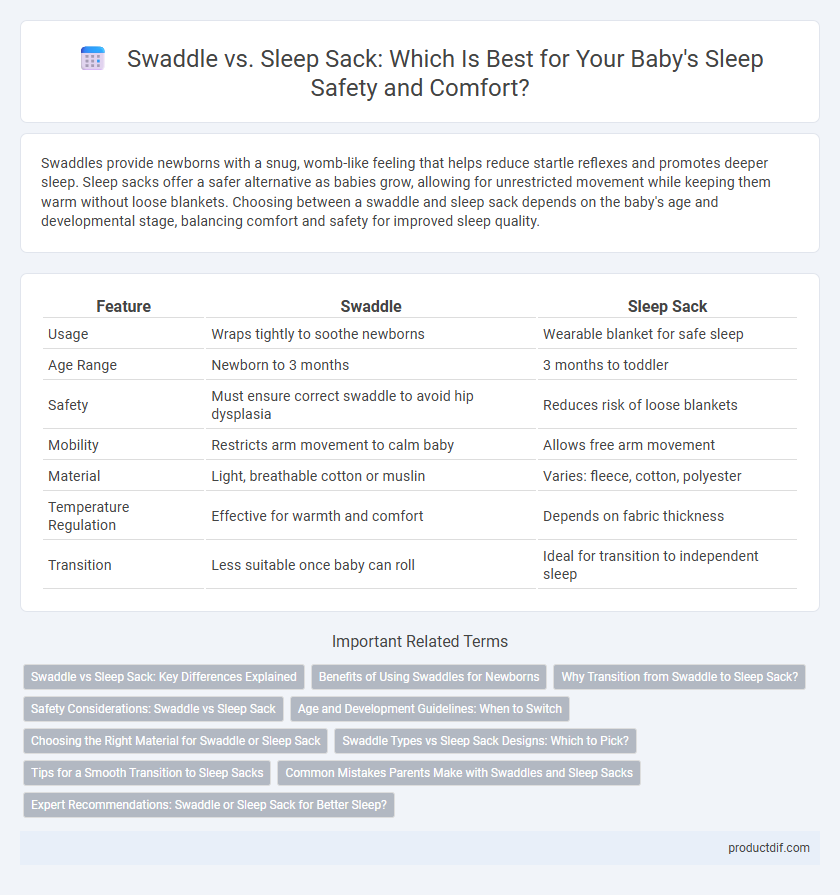Swaddles provide newborns with a snug, womb-like feeling that helps reduce startle reflexes and promotes deeper sleep. Sleep sacks offer a safer alternative as babies grow, allowing for unrestricted movement while keeping them warm without loose blankets. Choosing between a swaddle and sleep sack depends on the baby's age and developmental stage, balancing comfort and safety for improved sleep quality.
Table of Comparison
| Feature | Swaddle | Sleep Sack |
|---|---|---|
| Usage | Wraps tightly to soothe newborns | Wearable blanket for safe sleep |
| Age Range | Newborn to 3 months | 3 months to toddler |
| Safety | Must ensure correct swaddle to avoid hip dysplasia | Reduces risk of loose blankets |
| Mobility | Restricts arm movement to calm baby | Allows free arm movement |
| Material | Light, breathable cotton or muslin | Varies: fleece, cotton, polyester |
| Temperature Regulation | Effective for warmth and comfort | Depends on fabric thickness |
| Transition | Less suitable once baby can roll | Ideal for transition to independent sleep |
Swaddle vs Sleep Sack: Key Differences Explained
Swaddles tightly wrap infants to mimic the womb's snug environment, promoting better sleep and reducing startle reflex. Sleep sacks, also known as wearable blankets, provide a safer alternative by allowing freedom of movement while maintaining warmth without loose blankets. Understanding these differences helps parents choose the right sleep solution based on the baby's developmental stage and safety needs.
Benefits of Using Swaddles for Newborns
Swaddles provide newborns with a secure, womb-like environment that helps reduce the startle reflex, promoting longer and more restful sleep. They offer the benefit of temperature regulation and minimize the risk of sudden infant death syndrome (SIDS) by encouraging back sleeping. Unlike sleep sacks, swaddles ensure the baby's arms remain snugly wrapped, enhancing comfort and calming fussy infants.
Why Transition from Swaddle to Sleep Sack?
Transitioning from a swaddle to a sleep sack is essential as babies begin to show signs of rolling over, ensuring safer sleep by reducing the risk of suffocation and Sudden Infant Death Syndrome (SIDS). Sleep sacks offer greater freedom of movement while maintaining warmth, promoting healthy motor development. Parents often choose sleep sacks for their breathable materials and ease of use during nighttime diaper changes, enhancing both comfort and safety.
Safety Considerations: Swaddle vs Sleep Sack
Swaddles provide snug wrapping that can help reduce startle reflex and promote sleep but must be used correctly to avoid risks like hip dysplasia or overheating. Sleep sacks offer a safer alternative by eliminating loose blankets while allowing free arm movement, reducing suffocation and Sudden Infant Death Syndrome (SIDS) risks. Choosing the right option depends on the baby's age, development, and individual safety guidelines recommended by pediatric experts.
Age and Development Guidelines: When to Switch
Swaddles are ideal for newborns up to 3 months old, providing a snug environment that mimics the womb and helps reduce startle reflexes. Sleep sacks become appropriate around 3 to 6 months when babies start showing signs of rolling over, offering safe mobility and reducing the risk of overheating. Transitioning from swaddle to sleep sack aligns with developmental milestones to ensure both comfort and safety during sleep.
Choosing the Right Material for Swaddle or Sleep Sack
Choosing the right material for swaddles or sleep sacks is crucial to ensure your baby's comfort and safety during sleep. Natural fibers like organic cotton and bamboo offer breathability and softness, reducing the risk of overheating and skin irritation. High-quality fabrics with moisture-wicking properties support a cozy sleep environment, promoting better rest for your little one.
Swaddle Types vs Sleep Sack Designs: Which to Pick?
Swaddle types include traditional cotton wraps, muslin blankets, and adjustable Velcro options, each offering varying levels of snugness and breathability to cater to different infant preferences and safety needs. Sleep sack designs range from sleeveless, wearable blankets to zippered or buttoned variants made with organic cotton or fleece, providing comfort and freedom of movement while reducing the risk of overheating. Choosing between swaddle types and sleep sack designs depends on the baby's development stage, temperature sensitivity, and parental preference for ease of use and safety features.
Tips for a Smooth Transition to Sleep Sacks
Choose sleep sacks with adjustable sizing and breathable fabrics to ensure comfort and safety during your baby's transition from swaddles. Introduce the sleep sack gradually by using it during nap times before bedtime, allowing your baby to get used to the feel and warmth. Maintain a consistent bedtime routine including soothing activities like gentle rocking or singing to ease the adjustment and promote restful sleep.
Common Mistakes Parents Make with Swaddles and Sleep Sacks
Common mistakes parents make with swaddles include tightly wrapping infants, which can restrict hip movement and increase the risk of hip dysplasia. In contrast, using sleep sacks improperly, such as choosing the wrong size or ignoring weight limits, can lead to overheating or discomfort. Ensuring proper fit and understanding safe usage guidelines reduces risks and promotes better sleep safety for babies.
Expert Recommendations: Swaddle or Sleep Sack for Better Sleep?
Experts recommend swaddles for newborns up to 3 months to promote a secure feeling and reduce startle reflex, enhancing sleep quality during early infancy. Sleep sacks are advised for older babies transitioning out of swaddles, providing warmth and freedom of movement while maintaining safety by eliminating loose blankets. Pediatric guidelines emphasize choosing the option that suits the baby's age and development stage to ensure optimal sleep and reduce the risk of Sudden Infant Death Syndrome (SIDS).
Swaddle vs sleep sack Infographic

 productdif.com
productdif.com